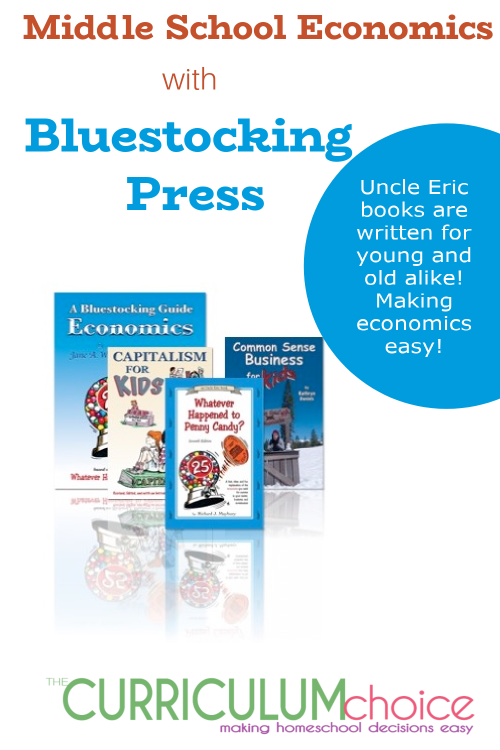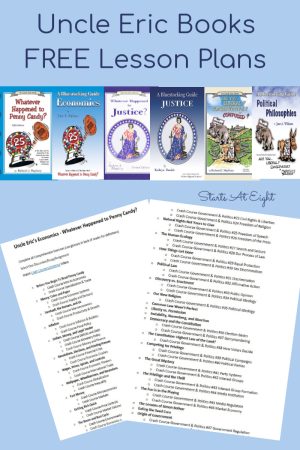I have been searching for an economics course that would be suitable for middle school students. Much to my pleasure, I found exactly what I was looking for to teach middle school economics with Bluestocking Press!

Middle School Economics with Bluestocking Press
The Uncle Eric books (economics books from Bluestocking Press), written by Richard J. Maybury, are designed for young and old alike. Using the epistolary style of writing (using letters to tell a story), Mr. Maybury plays the part of an economist writing a series of letters to his niece or nephew. With stories and examples, he gives interesting and clear explanations of topics that are generally thought to be too difficult for anyone but experts.
Whatever Happened to Penny Candy?
Whatever Happened to Penny Candy? was recommended to me over and over, which was what originally led me to the Bluestocking Press site. I was overjoyed to find an entire curriculum set for middle school students that included not only the book I was looking for, but three others!

Whatever Happened to Penny Candy is a simply written book of 15 chapters that helps students (and adults like me) understand the basics of the economics system in the United States. Not only that, but it incorporates history and current events in as well.
In real terms that aren’t weighty and hard-to-grasp, your children will finish this book with more information than I was ever taught (even in college) about such things as wages, inflation, recessions, federal debt, and so much more. Even better, there’s a common-sense sort of humor to the book that kept me chuckling all the way through.
A Bluestocking Guide: Economics

A Bluestocking Guide: Economics is a sort of workbook/test book/extra study guide to go along with Whatever Happened to Penny Candy. It includes extra articles to further study and understanding of each chapter in the “primer” (which is Whatever Happened to Penny Candy), as well as discussion questions and tests. The tests include everything from short answers and definitions to multiple choice and essay questions. Further reading lists, charts and diagrams are included, too.
You could read the primer without using this book, but it really helps round out the course.
Common Sense Business for Kids

Common Sense Business for Kids is 17 chapters, but only 62 pages of just what it says – common sense. Students learn the ins and outs of what it takes to successfully run a business – things like operating costs, markets, needs vs. wants, changing with the times, keeping inventory, employees and salesmanship.
Since each chapter is only a few pages, the info is not in depth, but instead very to-the-point. I find that extremely refreshing, and I have a feeling your kids will, too!

Capitalism for Kids
Capitalism for Kids is subtitled Growing Up to Be Your Own Boss. With a little more depth and a different range of topics, this book continues on the same theme as Common Sense Business for Kids.
Chapters focus on such topics as evaluating what sort of business best suits the child’s interests and talents, capitalism vs. communism and socialism, family businesses, investing time and money, gaining education and experience, and even such things and laws and licenses.
Again, I really like the common sense writing that isn’t too wordy or philosophical. Quite simply it’s written to kids for them to read themselves, making it a wonderful option for middle school economics.
Even though this curriculum is suggested for middle school, I found it to be meaty enough for many high school students.
Bluestocking Press Economics for High School
If you’re hoping to find a set put together specifically for high school, Bluestocking Press offers two:
1. Economics Course for High School Students
2. Economics and Nature of Government for High School Students
Both contain some of the same books that are in the middle school kit, so you will want to decide which age level you’d most like to purchase and then purchase only that set. On the other hand, all of the books contained in the sets are available individually for those who would prefer to simply go through one or two books.
Using Uncle Eric Books for Economics & Participation in Government

Our Managing Editor, Heidi Ciravola, has used Bluestocking Press books for high school economics as well as Participation in Government, here she outlines how she did that and includes FREE Lesson Plans.
“Using Uncle Eric Books is a simple and engaging way to fulfill High School Economics and Participation in Government credits.
New York State Homeschool Regulations state that in high school our students have to complete .05 credits of Economic study, and .05 credits of Participation in Government studies.
We have done our Homeschool High School Economics and Participation in Government using Uncle Eric Books from Bluestocking Press. Here I will outline the books to use, the order to use them in and offer up FREE Printable Lesson Plan Schedules to complete these courses.”
More Homeschool Economics Options
Economics for Everybody – Economics: it’s everywhere, influencing everything — and so rarely understood.
Economics for Everybody seeks to remedy that through an insightful and entertaining exploration of the principles, practices, and consequences of economics. Thoroughly unconventional, this church, family, and homeschool economics curriculum links entrepreneurship with lemonade, cartoons with markets, and Charlie Chaplin with supply and demand.” ~ Compass Classroom
Economics for High School with Mr. D Math – is a half credit, online course for high school students. The course contains 16 lessons and is self-paced so you can spread it out however you like.
~ Originally published March 2011. Written by Cindy, eclectically Charlotte Mason mom of three from Central KY. You can find her blogging at Our Journey Westward.

I love the Bluestocking Press books! We don’t yet have the business ones, though. Thanks for reviewing them.
Annie Kate
We are using these as part of our government/economics course in my son’s senior year of high school. We have read Whatever Happened to Penny Candy? Whatever Happened to Justice? Money Mystery, and Clipper Ship Strategy (along with corresponding guides). There is no way we would have gleaned a fraction of the information until this year working along with our Modern History study. I would squarely put these in a high school course for maximum benefit.
Great review and information. Thanks for sharing these books with other homeschooling families. We have found them to be valuable and relevant.
Could this be used in a co-op? I’m looking for something that is year-long for middle schoolers that has lesson plans.
Linda,
I can easily see it for use with a co-op. There aren’t a lot of hands-on, cooperative activities, but assigned reading and discussion time for sure.